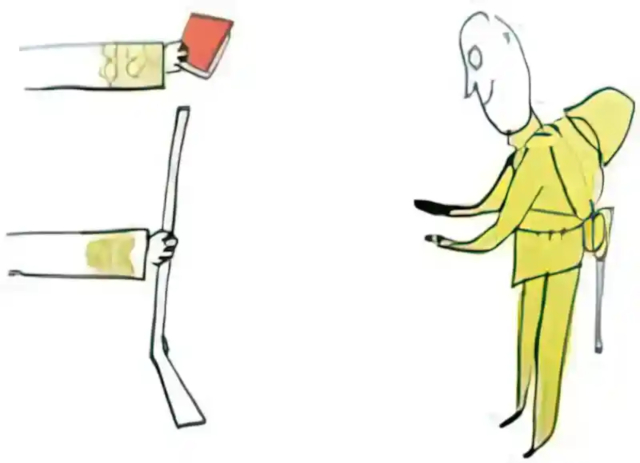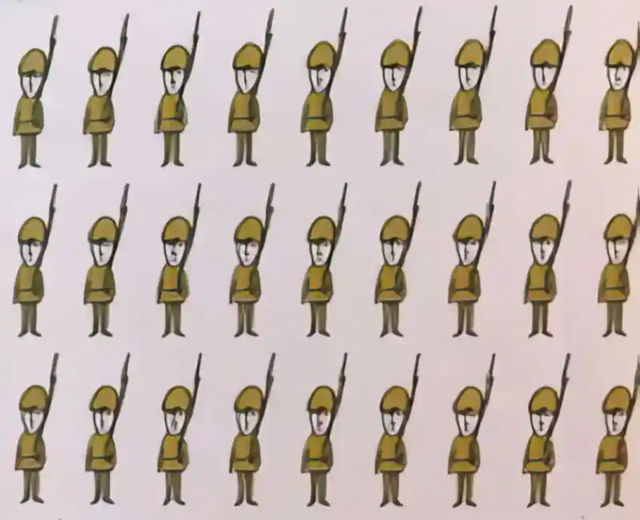Mankind has been plagued by war since the beginning of civilization. History proves this well. Not just these days, but these centuries have always been war. But these days, by virtue (or perhaps evil) of the availability of social media and the internet, we, I mean the semi-humans become more aware of war news and get used to it; and this is pathetic. Although Enemy written by Davide Cali and illustrated by Serge Bloch is a book for children there, perhaps similar to Saint-Exupery’s The Little Prince which, according to my personal opinion is a must for every bookshelf and every age group, ought to be a copy of it in every house to be read once in a while so that it may erase the dust in our memory of being human and remaining human.

In the picture on the cover, we see a smiling general with a small head on his big body like a vase. A body, as if, whose bulk’s only purpose is to place various and irregular medals on itself. A smile covers the whole volume of his face; a smile that seems so deep and satisfying that it leaves no room for the skull and subsequently its contents. But blood drips from our brainless, smiling, obese general’s hands. It is mentioned in Abrams’ A Glossary of Literary Terms, “A paradox is a statement which seems on its face to be logically contradictory or absurd yet turns out to be interpretable in a way that makes sense” (267). Here too, the bloody hands of the thin-brained general are in contradiction with his smile and ridiculous face. But a little pondering reveals this contradiction; is it not the case that all these generals are dear, loving, kind fathers, friends, and husbands in their houses and among their friends as they give orders for the massacre?
We pass the first Parergon and enter the second to face an army of identical soldiers, all closed eyes with a knot in their eyebrows, mustard gas coloured, and ready to serve. As if we have entered The Nutcracker and the Mouse King’s world where Mary’s invented machine has brought to life the tin soldiers!
Entering the third parergon, a black page, a sentence in red captures our attention: “There is a war on…” as if the story’s eternal end has already been revealed to us! That war will go on forever, and ever. The blood colour of this sentence with the three dots at its end is evidence of this claim.
The fourth parergon, “Here’s something that could be a desert…” we hear silence, just as though to invite us to watch the barren civilisation after the war; yet again we face the function of “…” and the never-ending repetition of this round. The fifth and sixth parerga with the two remaining holes of this civilisation and their two soldiers! And “They are enemies.” In the seventh parergon, signifying these soldiers are blood enemies. The very next page becomes all in blood colour and for the first time, we encounter the protagonist/ narrator who sits on a platform above some stairs: Mr Soldiers. And the story continues with this crucial sentence: “The enemy is there but you never see him.” The pictures are identical, and we cannot figure out which of these two soldiers is the narrator, or if this is a conversation between these two holes; neither has seen the Other. Every morning, both shoot at a blind spot in the air and then eat their food, knowing that the other is alone in his bunker. More significantly, these two are absolutely detached from the world. At this moment, the reader hesitantly asks her/himself: what if these two belong to the same corps? What if these two are the sole survivors of humans? “Here’s something that could be a desert… in which there are two holes.” And does it mean there is nothing left of the world? The protagonist knows quite well that the Other is alone and shares the same hunger with him: “Yes, I am sure he is alone too. And he’s hungry. These are the only two things we have in common, the enemy and me”. But if we consider the setting as a crystal ball, our soldier/ protagonist is seeing the disturbed reflection of himself, and nothing more. And that Other3 person is a monster for it has been written in the manual!

But curiosity takes the best of him and forces him to go out of his bunker and dig into the Other’s shelter, and what is shocking and unbelievable for him is the discovery of the Other’s humanity. The Other also has a photo of his family and a manual, thus, to save lives that Other is also fighting against this Other, the I, accordingly, is not a monster either in this way, he thinks of me – the Other – as a monster, because it has been written in the manual. “I wasn’t expecting this. They didn’t tell us anything about this. … A manual just like mine. It’s the same one, the enemy has my face! But I’m not like that, I’m not a monster.” Hence, he also looked at the starry sky at night and realized the futility of war. And ironically, that Other person is also busy with these moments and thoughts in the bunker of this Other person. This is the moment that The Man He Killed, by Thomas Hardy, comes to the reader’s mind:
“Had he and I but met
By some old ancient inn,
We should have sat us down to wet
Right many a nipperkin!
“But ranged as infantry,
And staring face to face,
I shot at him as he at me,
And killed him in his place.
“I shot him dead because —
Because he was my foe,
Just so: my foe of course he was;
That’s clear enough; although
“He thought he’d ‘list, perhaps,
Off-hand like — just as I —
Was out of work — had sold his traps —
No other reason why.
“Yes; quaint and curious war is!
You shoot a fellow down
You’d treat if met where any bar is,
Or help to half-a-crown.”
Here too, two people consider each other as enemies without knowing why, simply because they have enlisted for the war. Enemies who, in any other situation, could easily be friends; enemies who have volunteered to kill others, not even out of national pride or to defend their families, but out of hunger and unemployment. In this poem, the connection between the chaos of internal affairs and its projection outside borders, to the Other, as the basis of starting wars by the politicians and warlords is revealed. It seems that in Thomas Hardy’s poem, like the soldiers of David Cali’s Enemy, even though the soldiers are shooting each other, they cannot see or think about the truth that they must not kill one another; they are blind, for the commanders/ manual orders that.

Two soldiers, mustard gas coloured, two Others, two humans, two confused and lonely monsters in a desert of the remnants of civilization waiting for the end of the war because these two have finally realized: “I am a man. This manual is filled with lies. It wasn’t me who began this war!” but there’s no news of the commanders and their orders, thus, these two get to work and send messages to each other hoping to reach an agreement to end this madness; although, we know from the beginning of this story that “There’s a war on…” and behind this desert there is an army of identical, mustard-gas-coloured soldiers with eyes closed and a knot in their eyebrows standing in never-ending rows…

…
The three thousandth century,5
And still war with no victory…
Adam’s descent, from the very beginning, has also been…
The luscious flesh of the lands and we were left
With a God who had always been nought
And the axes that sank down to
Fertilize the sterile blood
I swear by “I” who am not
By “thee” who for my absence makest even the Fire proud
I swear by Envy’s Arch-Prophets
By Wrath’s naked Ressentiment
By Coldness of a farm of corpses
Whose ashes are inherited
I swear by One to whose soul He told we are organs
Yet not knowing pieces within a thick dark…
Breathe!
For the sake of the One who created Contempt
Breathe,
Of love’s breed was not “Adam”
Of being nought “Nothingness”
In the Pain’s likeness, In the likeness of Pride’s Vanity, as crimson as Jealousy
Breathe as when Dusk makes love with Dawn
Breathe

And the formidable sound of silence
Crumbled on my head.
Behnaz Amani is an English literature PhD, a poet, researcher, and women and children’s rights activist.
Work Cited
Original Contents by Critical Legal Thinking